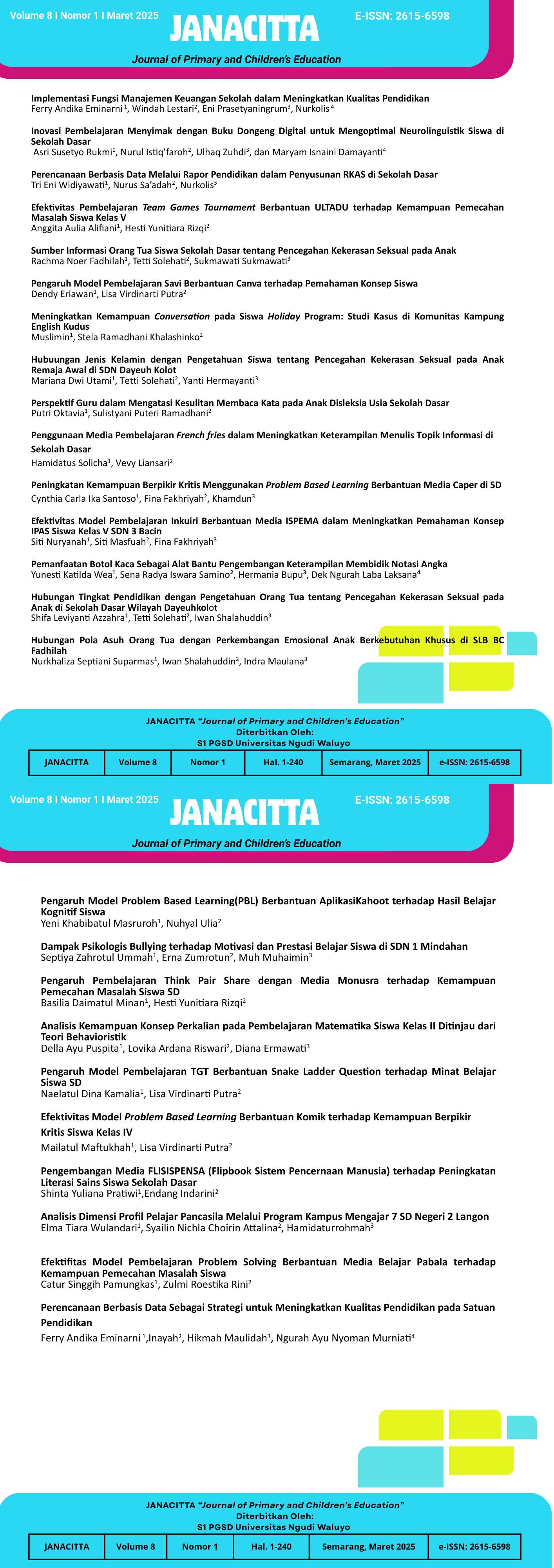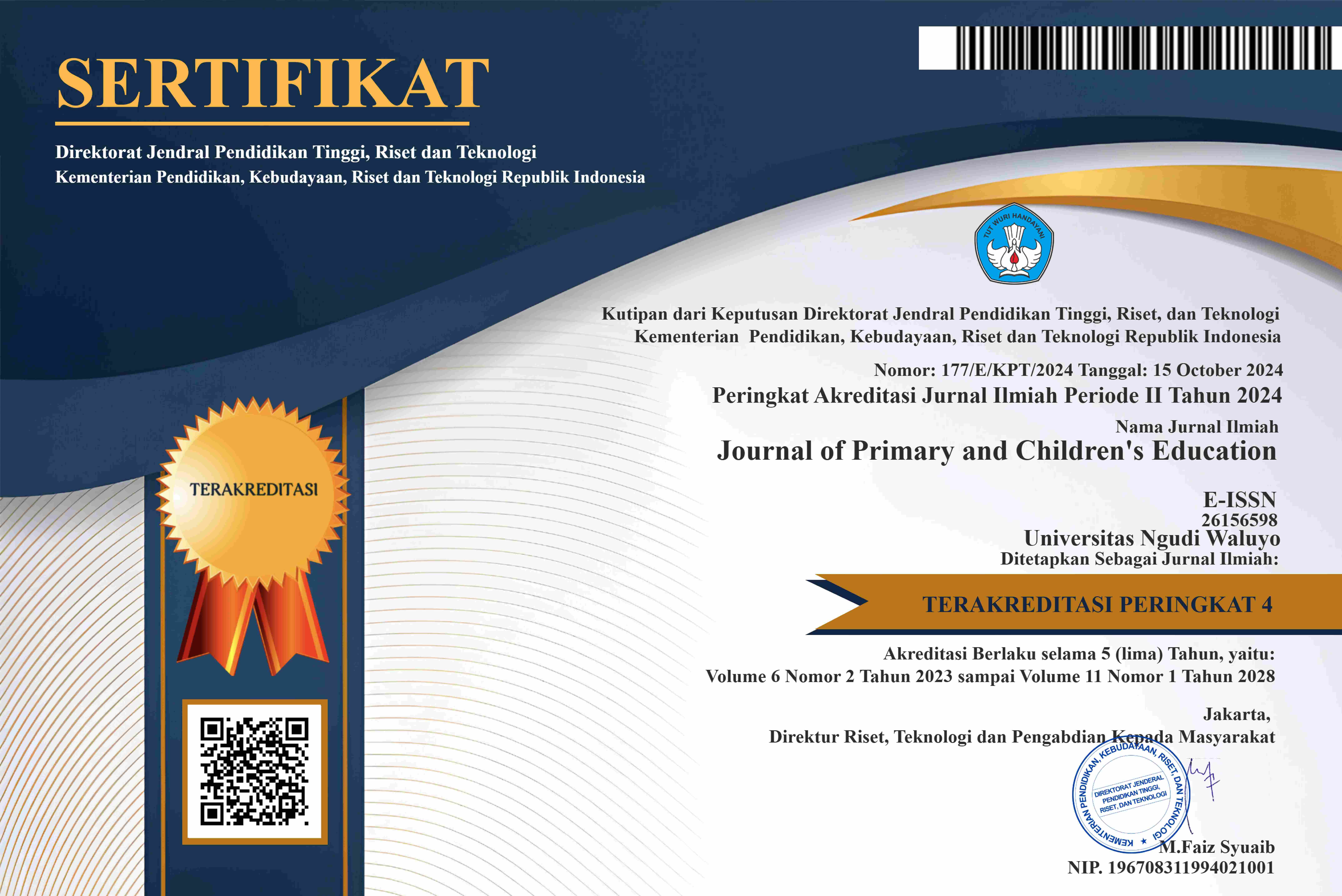Pengembangan Media FLISISPENSA (Flipbook Sistem Pencernaan Manusia) terhadap Peningkatan Literasi Sains Siswa Sekolah Dasar
DOI:
https://doi.org/10.35473/janacitta.v8i1.3813Abstract
Abstract
The purpose of this research and development is to describe the development of media, the level of media validity, the effectiveness of the media, and the practicality of FLISISPENSA (Human Digestive System Flipbook) media towards increasing elementary students' science literacy. The method used in this research is Research and Development (R&D) with the ADDIE development model. The stages in this development research include problem identification, data collection, product design, product design validation, product design revision, field trials, and evaluation. The results of the validation carried out by material experts show a percentage score of 96% with a “very high” category, while for media experts get a percentage rate of 94.66% with a “very high” category, and for learning design experts receive a score of 94% with a “very high” category. The effectiveness of the media is seen from the results of the T Test which produces a sig. value of 0.001, which is smaller than 0.05, so it can be concluded that there is an increase in the value of science literacy from 64% to 86%. Meanwhile, the results of practicality based on student assessment reached a percentage of 87.37% with the criteria “very practical”, and according to the teacher's assessment got a percentage of 97% with the category “very practical”.
Abstrak
Tujuan penelitian dan pengembangan ini adalah untuk mendeskripsikan pengembangan media, tingkat validitas media, keefektifan media, dan kepraktisan media FLISISPENSA (Flipbook Sistem Pencernaan Manusia) terhadap peningkatan literasi sains siswa SD. Metode yang digunakan dalam penelitian ini adalah Research and Development (R&D) dengan model pengembangan ADDIE. Tahapan dalam penelitian pengembangan ini mencakup identifikasi permasalahan, pengumpulan data, desain produk, validasi desain produk, revisi desain produk, uji coba lapangan, dan evaluasi. Hasil dari validasi yang dilakukan oleh ahli materi menunjukkan persentase skor sebesar 96% dengan kategori “sangat tinggi”, sementara untuk ahli media mendapatkan angka persentase 94,66% dengan kategori “sangat tinggi”, dan untuk ahli desain pembelajaran menerima skor 94% dengan kategori “sangat tinggi”. Efektivitas media terlihat dari hasil uji T Test yang menghasilkan nilai sig. sebesar 0.001, yang lebih kecil dari 0.05, sehingga dapat disimpulkan terdapat peningkatan dalam nilai literasi sains dari 64% menjadi 86%. Sedangkan, hasil kepraktisan berdasarkan penilaian siswa mencapai persentase 87,37% dengan kriteria “sangat praktis”, dan menurut penilaian guru mendapatkan persentase 97% dengan kategori “sangat praktis”.
References
Andriyani, N. L., & Suniasih, N. W. (2021). Development of Learning Videos Based on Problem-Solving Characteristics of Animals and Their Habitats Contain in IPA Subjects on 6th-Grade. Journal of Education Technology, 5(1), 37. https://doi.org/10.23887/jet.v5i1.32314
Dini et al. (2023). Pengembangan Web Interaktif “Hai Si IPA” untuk Meningkatkan Literasi Sains di Sekolah Dasar. Cetta: Jurnal Ilmu Pendidikan, 6(4), 829–842. https://doi.org/10.37329/cetta.v6i4.2818
Dwi et al. (2022). Pengaruh Model Problem Based Learning berbantuan Permainan Monopoli terhadap Kemampuan Pemecahan Masalah Siswa. JANACITTA : Journal of Primary and Children’s Education, 5(024), 39–46. http://jurnal.unw.ac.id/index.php/janacitta
Endang Indarini et al. (2013). Pengetahuan Metakognitif untuk Pendidik dan Peserta Didik. Satya Widya, 29(1), 40. https://doi.org/10.24246/j.sw.2013.v29.i1.p40-46
Huda. (2020). Perkembangan Teknologi Informasi dan Komunikasi (TIK) terhadap Kualitas Pembelajaran di Sekolah Dasar. Jurnal Pendidikan dan Konseling (JPDK), 2(1), 121–125. https://doi.org/10.31004/jpdk.v1i2.622
Huda et al. (2021). Peningkatan Keterampilan Berpikir Kritis Siswa melalui Model Problem Based Learning pada Siswa Sekolah Dasar. Jurnal Basicedu, 5(3), 1547–1554. https://doi.org/10.31004/basicedu.v5i3.973
Imawati et al. (2022). Pengembangan Video Pembelajaran pada Materi Sistem Organ Pencernaan Manusia untuk Meningkatkan Literasi Sains Siswa Sekolah Dasar. Jurnal Basicedu, 6(5), 8923–8935. https://doi.org/10.31004/basicedu.v6i5.3974
Karni et al. (2023). Pengembangan Bahan Ajar Flipbook dalam Peningkatan Literasi Sains di SDN Kalisapu 04. Journal of Education Research, 4(4), 1634–1644.
Kristiawan, M. (2014). A Model for Upgrading Teachers Competenceon Operating Computeras Assistant of Instruction. Global Journal of Human-Social Science: G Linguistics & Education , 14(5), 43–55.
Narut et al. (2019). Literasi Sains Peserta Didik dalam Pembelajaran IPA di Indonesia. Jurnal Inovasi Pendidikan Dasar, 3(1), 61–69.
Nurwidiyanti et al. (2022). Jurnal Basicedu. Jurnal Basicedu,. Jurnal Basicedu, 6(5), 6(4), 6949–6959. https://journal.uii.ac.id/ajie/article/view/971
OECD. (2023). PISA 2022 RESULTS. In PISA in Focus (pp. 1–25). https://www.oecd.org/pisa/
Sugiyono. (2018). Metode Penelitian & Pengembangan. Alfabeta.
Sulistiyowati et al. (2024). Literasi Digital: Strategi Pembelajaran IPAS di Kelas V SDN Bakaran Wetan 03. JANACITTA : Journal of Primary and Children’s Education, 7(September), 89–96.
Syofyan et al. (2019). Use of Integrated Thematic Teaching Materials Based on Problem Solving in Natural Science Learning in Elementary Schools. https://doi.org/10.4108/eai.21-11-2018.2282034
Trisiana, A. (2020). Penguatan Pembelajaran Pendidikan Kewarganegaraan melalui Digitalisasi Media Pembelajaran. Jurnal Pendidikan Kewarganegaraan, 10(2), 31. https://doi.org/10.20527/kewarganegaraan.v10i2.9304
Yuliani et al. (2022). The Development of Flipbook Based on the Addie Model in Science Learning for Elementary School Students. IJLI: International Journal of Learning and Instruction, 4(1), 56–64.
Yulianti et al. (2023). Pengembangan Media Flipbook Digital Berbasis Literasi Sains Materi Mengubah Bentuk Energi pada Siswa Kelas IV SDN 02 Pandean. Al-Madrasah: Jurnal Pendidikan Madrasah Ibtidaiyah, 7(3), 1432. https://doi.org/10.35931/am.v7i3.2559
Downloads
Published
How to Cite
Issue
Section
License
Copyright notice:
- Authors retain copyright and grant the journal right of first publication with the work simultaneously licensed under Creative Commons Attribution License that allows others to share the work with an acknowledgement of the work's authorship and initial publication in this journal.
- Authors are able to enter into separate, additional contractual arrangements for the non-exclusive distribution of the journal's published version of the work (e.g., post it to an institutional repository or publish it in a book), with an acknowledgement of its initial publication in this journal.
- Authors are permitted and encouraged to post their work online (e.g., in institutional repositories or on their website) prior to and during the submission process, as it can lead to productive exchanges, as well as earlier and greater citation of published work (The Effect of Open Access)







